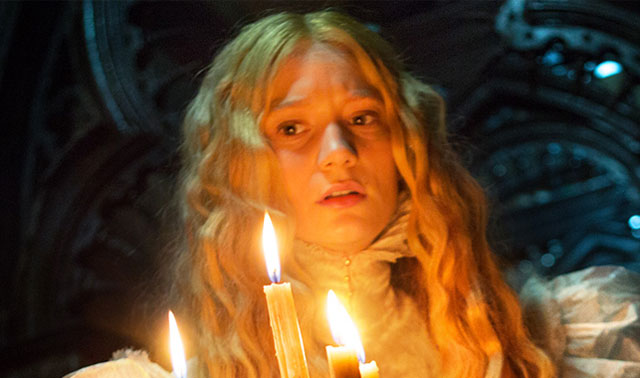
Having channelled the giddy enthusiasm of a 10-year old boy watching mecha cartoons in 2013’s Pacific Rim, Guillermo del Toro taps into the fevered imaginings of a “bookish 14-year old girl” for his new movie, Crimson Peaks. Though marketed as a horror movie, the Mexican director’s new film is as much a stylised period romance as it is a gothic shock show.
It’s the sort of movie that doesn’t get made often these days, harking back to 1940s psychological thrillers like Gaslight and Hitchcock’s Rebecca, though with some lurid lashings of the Hammer House of Horror flicks and a dash of the surreal, sensational elements of Italian Giallo. Even more than that, it harks back to Wuthering Heights and Jane Eyre, arguably the smarter precursors of the much-maligned Twilight books and movies.
The handsome, expensive production is dead serious about high-gothic motifs that were already as creaky as the rotting floorboards in a haunted house when Jane Austen parodied Ann Radcliffe in Northanger Abbey. Del Toro piles up melodramatic happenstance and layers on ornate phantasmagorias as he plumbs the depths of his heroine’s tortured psyche, in such apparent awe of his influences that he daren’t poke fun at them.

It’s a testament to the regard in which Hollywood holds Del Toro that he could get financing for a feature as indulgent and as commercially unviable as this. Crimson Peak feels out of step of a time when most horror productions are post-modern snark (Cabin in the Woods, the upcoming Pride and Prejudice and Zombies) or cheaply made slashers and torture porn (anything by Eli Roth).
Compared to even to The Babadook or It Follows, two of the best horror films of recent years, Crimson Peak doesn’t have a clear elevator pitch or target market. Little wonder that this misshapen grotesquery has confused so many critics and flopped at the American box office — too gory for an older, more literary crowd; too mannered and old-fashioned for the traditional horror demographic. The Hollywood Reporter dismisses it, somewhat unfairly, as “the second best film of 1946”.
It’s a pity that Crimson Peak seems unlikely to find an audience outside a niche of English literature students. It’s Del Toro near the top of his form, as visually sumptuous and rich in subtext as Pan’s Labyrinth and as spooky as The Devil’s Backbone. The film centres on Edith Cushing (named in tribute to Hammer Horror stalwart Peter Cushing and played by Mia Wasikowska), the feisty, well-read, and yet naïve daughter of a wealthy American businessman.
As the magnates of American industry and commerce rise in the early 20th century, the fortunes of England’s aristocracy are falling. Among them are English baronet, Sir Thomas Sharpe (Tom Hiddleston) and his sister Lucille (Jessica Chastain), choking on the fumes of industrialisation as the decadent remains in a line of English gentry. They enter the lives of the Cushing family, seeking capital for a venture, and Sir Thomas leaves America with Edith as his bride.
He sweeps her off the family’s crumbling estate, Allerdale Hall, an astonishing feat of production design and perhaps the real star of the movie. Red clay from the mines below oozes onto the pristine snow blanketing the grounds of the property; meanwhile, the derelict mansion and the blood-spattered ghosts that roam inside are manifestations of Edith’s suppressed grief and her creeping sexual awakening.
This is a film, like the classic gothic works, about the eternal war between the id, ego and the superego, with sex and violence churning in the basement of Allerdale Hall and beneath the prim faces its characters present to the world. But like The Babadook and It Follows, it is also a film where the female characters overturn their traditional genre status as victims.
Wasikowska, who was so unnerving in the underrated Stoker, is arresting as the independent but idealistic Edith. She’s haunted, but resolute; plucky but vulnerable. Hiddlestone is a credible Byronic hero, though his character is sketchily written. And Chastain, who seems to be in everything at the moment, plays the role of sulky, stony sister with glee.
There are many problems with the script — wooden dialogue and plot holes abound — and there are some ropy CGI effects, but Crimson Peak is so committed to its histrionic, extravagant vision that it sucked me in, anyway. It demands to be experienced on its own terms, a rare studio film that feels like it was made with real directorial passion. It’s not unlike Pacific Rim in how sincerely it treats material others might play for laughs.
Del Toro, evidently worried about the marketing, tweeted: “One last time before release. Crimson Peak: not a horror film. A Gothic Romance. Creepy, tense, but full of emotion… Like my dancing.” It’s great that he’s still dancing to his own beat rather than the increasingly monotonous tune played by his studio paymasters. — © 2015 NewsCentral Media
- Read more: Crimson Peak and modern horror (major spoilers) and Crimson Peak erects and subverts the gothic family tree

